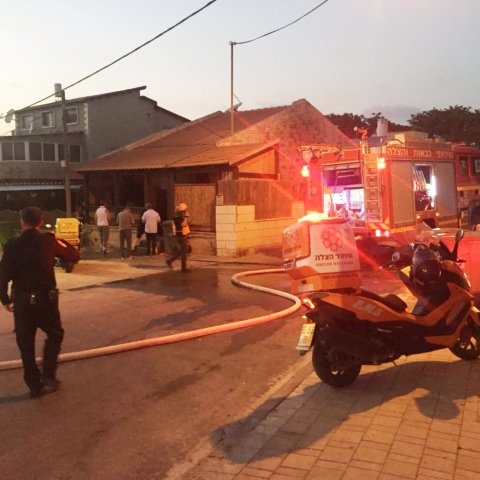
News

Sderot: a city of rockets, bomb shelters, and rock music
JORDAN MOSHE
Its residents are so accustomed to spending prolonged periods in bomb shelters, that the city has unique underground playgrounds so that its children will have fun in the long hours spent in shelters.
For these people, there is never any post-traumatic stress, simply because there is no “post” to the trauma from which they suffer.
This is according to a documentary, Rock in the Redzone, screened by the South African Zionist Federation last Thursday at Nu Metro Hyde Park in Johannesburg. It tells the story of the southern town on Israel’s periphery that has been the target of Qassam rockets for the past 14 years.
Established in 1951, Sderot is populated mainly by Jews of North-African and Middle-Eastern backgrounds who settled there during waves of mass immigration to the state in the 1950s. A city far from the Israel’s centre, Sderot not only lacks economic and educational opportunities, but has been hit by rockets more than 2 500 times since 2012.
Its citizens not only persevere, but thrive on hope, determination, and a great deal of rock and roll.
In 2007, Los Angeles filmmaker Laura Bialis arrived in Sderot to better understand the everyday reality of its residents, and capture their reality on film. The documentary took more than seven years to make, and it tells the personal stories of the people Bialis encounters. It also goes into what it feels like to have only 15 seconds to find shelter when the tzeva adom (code red) missile alert siren sounds.
In Sderot, Bialis doesn’t find a defeated population, but courageous youth, a bomb shelter music studio, and Avi Vaknin, a rock musician who eventually becomes her husband.
It is through the lens of music that Bialis studies the people of Sderot, a western Negev city in the southern district of Israel. She strives to get to the heart of what people feel by understanding how they use song and rhythm to express their fear and defiance.
What she finds is that music is not treated lightly, but is the life-blood of Sderot, empowering adults and children alike as they struggle to lead normal lives. Said Bialis, “I figured I could tell the story through the experience of the musicians. It was the music you’d imagine, the music that comes from really hard places.”
Sderot is a musically prominent locale, and has produced contemporary Israeli and North African rock influences, including Eurovision 2007 competitors Teapacks, Knesiyat Hasechel (Church of Reason), and Sfatayim (Lips).
Even the home of a bomb shelter turned music studio called Sderock, the city continues to make its mark on the entertainment scene in Israel, and on music trends globally.
What becomes clear as the documentary progresses is that there is more to the country than just Jerusalem and Tel Aviv. “Sderot, as much as it’s in the periphery, is a symbol of Israel,” said Bialis. “The way Israel acts toward Sderot is, in a way, the way the rest of the world acts toward Israel.”
Seemingly ignored by greater Israel, Sderot remained the sole target of rocket attacks until 2008, when neighbouring city Ashkelon was hit with three rockets. It was only then that the Israeli government responded, launching Operation Cast Lead, a military incursion into Gaza with the goal of dismantling terrorist infrastructure.
It was at this point that the residents of Sderot, who for years had tried to bring their plight to the attention of their government, became enraged. Watching the news coverage of the military operation, Vaknin, Bialis’s husband, said, “Now the government feels that we are under attack, not when we in Sderot faced this every single day for years. Are we less than the rest of Israel? Am I not a person?” Others expressed the same feelings, vocalising a sense of betrayal at the hands of their fellow Israelis.
This is just one dimension to the complex personalities of the people of Sderot. “Sderot is kind of like a parallel universe, a crazy existence, and it’s amazing and crazy that people keep on with it,” said Bialis.
We meet Vaknin’s bandmates and their roommates, the owners of the local restaurants and shops, as well as Hagit Yaso, a young Ethiopian-Israeli who ended up in the national Israeli talent show, A Star Is Born.
Bialis weaves in the events of seven years, marked by rockets and army incursions, incalculable damage and emotional upheaval, the departure of friends for other cities, even her own wedding, held in Sderot itself.
In 2014, the range of Hamas missiles launched from Gaza increased significantly, and the entire country effectively became Sderot.
Vaknin and Bialis agreed that they wouldn’t leave Sderot because of the rockets, but ended up leaving for Tel Aviv that same year to help boost Vaknin’s career and ease Bialis’s aliyah process. Shortly after the move, Vaknin was invited to join a studio as well as contribute to the albums of other musicians, including Shlomo Artzi and Kobi Oz.
Although the couple and their five-year-old daughter still visit Vaknin’s family almost every shabbat, Bialis remains unsure about whether they’ll move back to Sderot.
Irrespective of where they live, however, she and her husband remain connected to the city, its people, and its courageous culture. “There’s a defiance [about the people of Sderot, a sense of] of this is who I am, this is who I’m going to be, and it’s reflected in their music,” said Bialis. “If you live in a place where nothing can be taken for granted, every minute matters more.”




